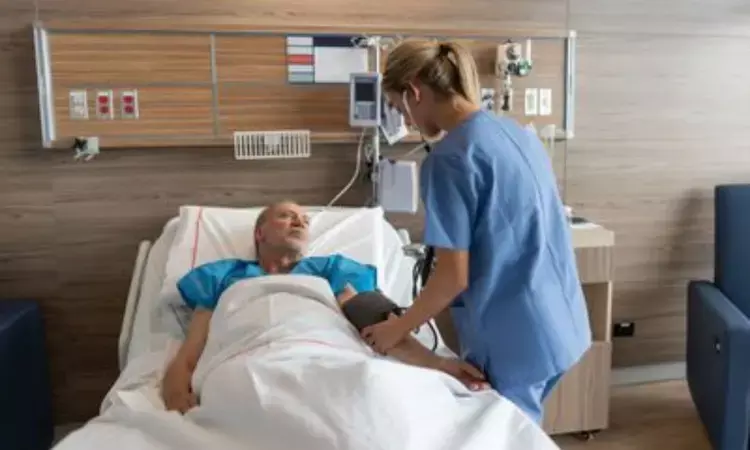- Home
- Medical news & Guidelines
- Anesthesiology
- Cardiology and CTVS
- Critical Care
- Dentistry
- Dermatology
- Diabetes and Endocrinology
- ENT
- Gastroenterology
- Medicine
- Nephrology
- Neurology
- Obstretics-Gynaecology
- Oncology
- Ophthalmology
- Orthopaedics
- Pediatrics-Neonatology
- Psychiatry
- Pulmonology
- Radiology
- Surgery
- Urology
- Laboratory Medicine
- Diet
- Nursing
- Paramedical
- Physiotherapy
- Health news
- Fact Check
- Bone Health Fact Check
- Brain Health Fact Check
- Cancer Related Fact Check
- Child Care Fact Check
- Dental and oral health fact check
- Diabetes and metabolic health fact check
- Diet and Nutrition Fact Check
- Eye and ENT Care Fact Check
- Fitness fact check
- Gut health fact check
- Heart health fact check
- Kidney health fact check
- Medical education fact check
- Men's health fact check
- Respiratory fact check
- Skin and hair care fact check
- Vaccine and Immunization fact check
- Women's health fact check
- AYUSH
- State News
- Andaman and Nicobar Islands
- Andhra Pradesh
- Arunachal Pradesh
- Assam
- Bihar
- Chandigarh
- Chattisgarh
- Dadra and Nagar Haveli
- Daman and Diu
- Delhi
- Goa
- Gujarat
- Haryana
- Himachal Pradesh
- Jammu & Kashmir
- Jharkhand
- Karnataka
- Kerala
- Ladakh
- Lakshadweep
- Madhya Pradesh
- Maharashtra
- Manipur
- Meghalaya
- Mizoram
- Nagaland
- Odisha
- Puducherry
- Punjab
- Rajasthan
- Sikkim
- Tamil Nadu
- Telangana
- Tripura
- Uttar Pradesh
- Uttrakhand
- West Bengal
- Medical Education
- Industry
High-sensitivity troponin HEART pathway allows earlier detection of acute MI: JAMA

USA: A recent cohort study published in JAMA Network Open has suggested that the high-sensitivity troponin HEART pathway may allow earlier detection of acute myocardial infarction (AMI) and improve resource use.
The multicenter cohort study involved 17 384 emergency department (ED) patients with chest pain risk stratified with a HEART pathway incorporating conventional vs high-sensitivity (hs) troponin levels. The study revealed that the high-sensitivity troponin group demonstrated a higher rate of AMI diagnosis during the ED visit and a lower AMI diagnosis rate within 30 days after the visit, along with lower rates of revascularization, stress testing, and admission. Mortality was rare and similar across groups.
Patients presenting to the EDs with chest pain are routinely risk-stratified for major adverse cardiac events (MACEs) using the HEART (History, Electrocardiogram, Age, Risk factors, and Troponin) score pathway. The pathway incorporates risk factors, clinical features, initial serum troponin testing, and electrocardiography findings hs-troponin levels are suggested to improve risk stratification among patients with possible acute myocardial infarction.
Mackensie Yore, Veterans Affairs/University of California Los Angeles National Clinician Scholars Program, Los Angeles, and colleagues aimed to compare resource use and health outcomes among emergency department patients undergoing cardiac risk stratification with a HEART pathway using conventional vs high-sensitivity serum troponin.
The study was conducted at 16 Kaiser Permanente Southern California hospitals during hs-serum troponin assay uptake. It included 17 384 adult patients who presented to an emergency department with chest pain and were risk-stratified with a HEART pathway based on high-sensitivity troponin or conventional troponin.
The study's main outcome was AMI detection in the ED and within 30 days.
The study led to the following findings:
- Of the 17 384 patients (median age, 58 years; 56.2% were women), 12 440 were risk stratified with a HEART pathway based on conventional troponin, and 4944 were risk stratified with a HEART pathway based on high-sensitivity troponin.
- Detection of AMI within 30 days was higher for the high-sensitivity troponin group than the conventional troponin group (5.8% versus 4.4%), while the 30-day all-cause mortality rate was unchanged (0.3% versus 0.4%).
- In the emergency department, 4.6% of patients in the high-sensitivity troponin group received a diagnosis of AMI compared with 2.0% in the conventional troponin group.
- Among those who did not receive a diagnosis of AMI in the emergency department, an additional 1.2% of patients in the high-sensitivity troponin group and 2.4% in the conventional troponin group received a diagnosis within 30 days.
- Patients in the high-sensitivity troponin group had lower rates of healthcare use compared with the conventional troponin group, including admission (12.2% versus 15.0%), stress testing within 7 days (10.2% versus 12.8%), and coronary revascularization within 30 days (1.0% vs 2.0%).
"The findings indicate that the hsTn HEART pathway was linked with higher rates of ED AMI diagnoses and lower rates of AMI diagnoses after the index ED visit and within 30 days," the researchers wrote.
The team added, "We also found less health service use for the hsTn group compared with the cTn group."
"A high-sensitivity troponin algorithm may improve the ED evaluation of AMI, both catching AMI earlier and mitigating advanced testing and unnecessary admission," they concluded.
Reference:
Yore M, Sharp A, Wu Y, et al. Emergency Department Cardiac Risk Stratification With High-Sensitivity vs Conventional Troponin HEART Pathway. JAMA Netw Open. 2023;6(12):e2348351. doi:10.1001/jamanetworkopen.2023.48351
Dr Kamal Kant Kohli-MBBS, DTCD- a chest specialist with more than 30 years of practice and a flair for writing clinical articles, Dr Kamal Kant Kohli joined Medical Dialogues as a Chief Editor of Medical News. Besides writing articles, as an editor, he proofreads and verifies all the medical content published on Medical Dialogues including those coming from journals, studies,medical conferences,guidelines etc. Email: drkohli@medicaldialogues.in. Contact no. 011-43720751


